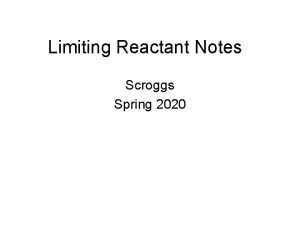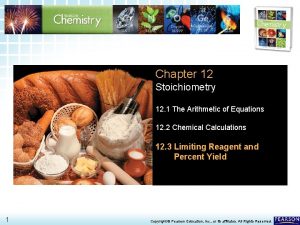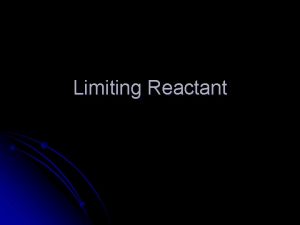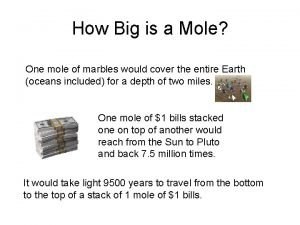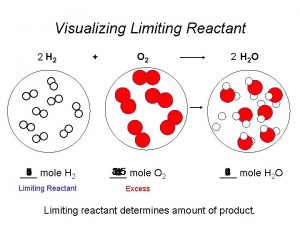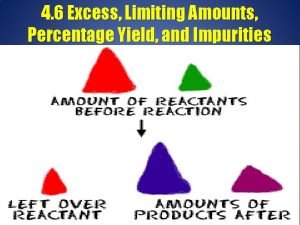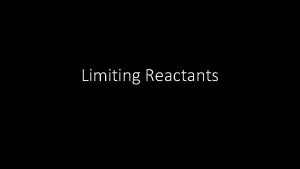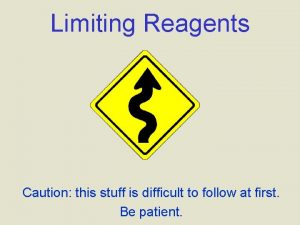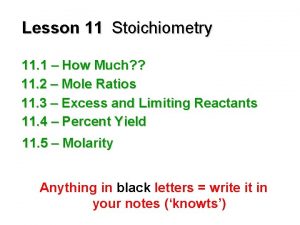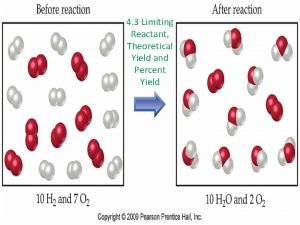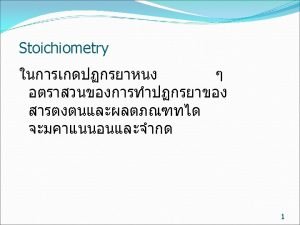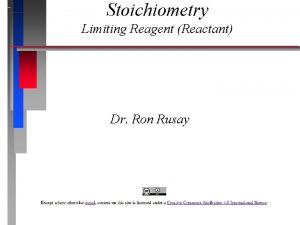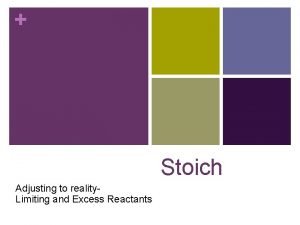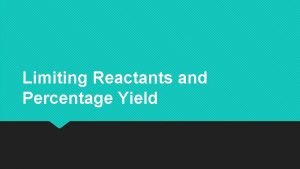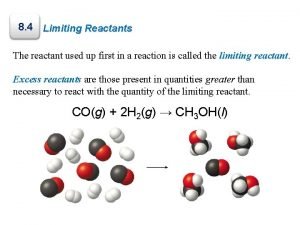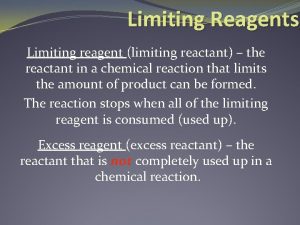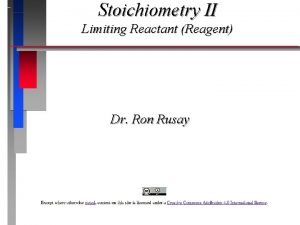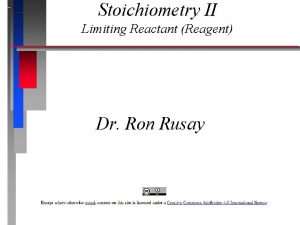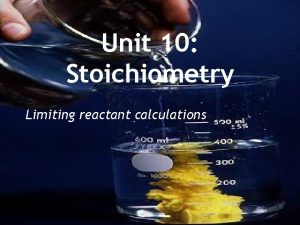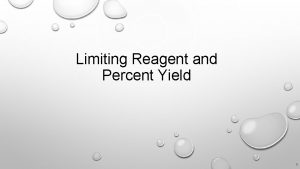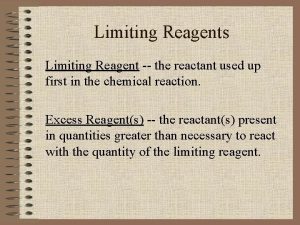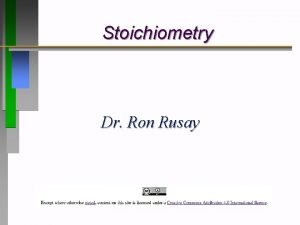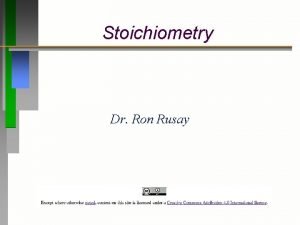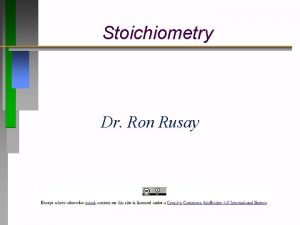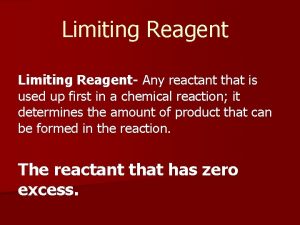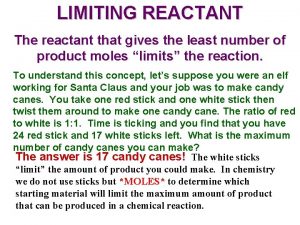Stoichiometry II Limiting Reactant Reagent Dr Ron Rusay




















- Slides: 20

Stoichiometry II Limiting Reactant (Reagent) Dr. Ron Rusay

Limiting Reactant An Ice Cream Sundae ? ? ?

Limiting Reactant An Ice Cream Sundae 8 scoops ice cream 6 cherries 100 m. L syrup What’s left? What’s totally consumed?

Limiting Reactant

QUESTION Consider the reaction between AB and B 2 in the gas phase: Select the correct statement about this reaction. A) The balanced equation for the reaction is AB + B 2 → AB 3. B) AB and B 2 are present in “stoichiometric” (equivalent molar) amounts at the start of the reaction to consume all of both. A) C) AB is the limiting reagent. B) D) The product of the reaction is A 2 B.

QUESTION

http: //www. cnafun. moa. gov. cn/zl/tjzl/201306/P 020130620619849846691. pdf QUESTION

Do you consume more or less than 2700 Cal/day (kcal/day)? Answer B. False World capacity (kcal) = 3. 04 x 1019 J x 1 cal/4. 184 J x 1 kcal/1000 cal World capacity (kcal) = 7. 26 x 1015 kcal (per year) World demand = 2700 kcal/ person x 1/day x 365 days/yr = 6. 9 x 1015 kcal (per year) What is recommended for your age and relative life style? http: //www. cnpp. usda. gov/publications/usdafoodpatterns/estimatedcalorieneedsperdaytable. pdf

Mass Applications: Determining a Limiting Reactant Does one of the reactants have fewer stoichiometrically adjusted moles than the other reactant? If so, the reactant with the smaller value is the limiting reactant. Calculation: q Divide the mass of each reactant by its respective Molar Mass and then by its Stoichiometric factor from the balanced equation. Compare the results. The lowest one is the limiting reactant. q

QUESTION

Mass Applications: Limiting Reagent ð How do masses of reactants relate? Is there enough mass of each reactant for the reaction to consume all of both of them or will there be some left of one of them? 2 C 8 H 18(l)+ 25 O 2(g) 16 CO 2(g)+18 H 2 O(l) What would happen if fuel injectors only provided 600. g of O 2 to react with 228 g of octane in the combustion chambers of your car?

Limiting Reagent Calculation ð The reactant present in the smallest molar amount considering stoichiometry limits the mass basis of any reaction. 2 C 8 H 18(l)+ 25 O 2(g) 16 CO 2(g)+18 H 2 O(l) 228 g octane / 114 g/mol = 2 mol octane 600. g oxygen / 32 g/mol = 18. 75 mol oxygen 2 mol octane / 2 mol (stoich. ) = 1 18. 75 mole oxygen / 25 mol (stoich. ) = 0. 75

Mass Effects of the Limiting Reagent What amount of octane remains unreacted in the reaction of 600. g of O 2 with 228 g of octane? 600. g O 2 x mol O 2 /32 g O 2 x [2 mol C 8 H 18 /25 mol O 2] x 114 g / mol C 8 H 18 = 171 g C 8 H 18 are reacted á 228 g - 171 g = 57 g C 8 H 18 remain unreacted á This car failed it’s smog test. The owner was told that it needs a $500 ring job!

Limiting Reagent / Theoretical “Yield” The limiting reagent governs theoretical yield of products. For the reaction of 228 g of octane with 600. g of oxygen, what is theoretical yield of carbon dioxide? 2 C 8 H 18(l)+ 25 O 2(g) 16 CO 2(g)+18 H 2 O(l) 600. g O 2 x mol O 2 /32 g O 2 x 16 mol CO 2 /25 mol O 2 x 44 g / mol CO 2 = 528 g CO 2

QUESTION

Calculate how much CO 2 is produced per gallon of gasoline (octane, C 8 H 18, d= 0. 70 g/ml) when gasoline is fully combusted with excess oxygen. 1. 0 gal C 8 H 18 ? lb CO 2

1. 0 gal C 8 H 18 ? lb CO 2 1. 0 gal x 3. 785 L/gal x 1000 m. L/L x 0. 70 g/m. L = 2649. 5 g C 8 H 18 2650 g mol C 8 H 18 16 mol CO 2 2 mol C 8 H 18 114 g C 8 H 18 44 g CO 2 mol CO 2 8181 g CO 2 ? g CO 2 18 lbs

Does the increase in “man-made” CO 2 affect global climate? ……. Harvey, Irma, Maria? How much CO 2 do you personally produce every week from just getting around? …. every month? …. every year? …. from other uses (lights, cell phones, computers? ) Why do people in developed nations, like the U. S. , Japan & in the EU, produce tons more of CO 2 person than people in under developed or in most of the developing nations?

Greenhouse Gases

What is a greenhouse gas? The sun’s energy & the molecule’s shape (polarity) decide. • Our atmosphere (air) is 78% nitrogen and 21% oxygen. (BOTH are not polar. ) • Neither are greenhouse gases. They do not absorb infrared radiation (heat). • However, H 2 O and CO 2 can absorb infrared energy. Without them earth would be very chilly. http: //zebu. uoregon. edu/1998/es 202/l 13. html
 Limiting reactant
Limiting reactant Limiting reagent and excess reagent
Limiting reagent and excess reagent Limiting reactants in a recipe
Limiting reactants in a recipe Rusay
Rusay Limiting reactant
Limiting reactant Avogadro
Avogadro Banana spl
Banana spl Xg-125g2
Xg-125g2 Visualizing the limiting reactant
Visualizing the limiting reactant Limiting reagent
Limiting reagent Excess reactant definition
Excess reactant definition Limiting reagent
Limiting reagent Limiting reactant shortcut
Limiting reactant shortcut Limiting reactant example
Limiting reactant example Excess reactant example
Excess reactant example Limiting reactant examples
Limiting reactant examples Excess reactant def
Excess reactant def Limiting reactant def
Limiting reactant def Limiting reactant definition
Limiting reactant definition Limiting reactant def
Limiting reactant def Limiting reactant definition
Limiting reactant definition
